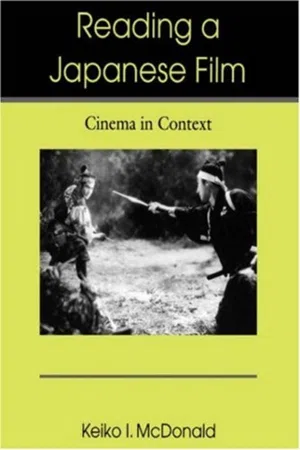
This is a test
- 308 pages
- English
- PDF
- Available on iOS & Android
eBook - PDF
Book details
Table of contents
Citations
About This Book
No detailed description available for "Reading a Japanese Film".
Frequently asked questions
At the moment all of our mobile-responsive ePub books are available to download via the app. Most of our PDFs are also available to download and we're working on making the final remaining ones downloadable now. Learn more here.
Both plans give you full access to the library and all of Perlego’s features. The only differences are the price and subscription period: With the annual plan you’ll save around 30% compared to 12 months on the monthly plan.
We are an online textbook subscription service, where you can get access to an entire online library for less than the price of a single book per month. With over 1 million books across 1000+ topics, we’ve got you covered! Learn more here.
Look out for the read-aloud symbol on your next book to see if you can listen to it. The read-aloud tool reads text aloud for you, highlighting the text as it is being read. You can pause it, speed it up and slow it down. Learn more here.
Yes, you can access Reading a Japanese Film by Keiko I. McDonald in PDF and/or ePUB format, as well as other popular books in Literature & Drama. We have over one million books available in our catalogue for you to explore.
Information
Table of contents
- Contents
- Preface
- Acknowledgments
- Introduction
- 1. Synergy of Theme, Style, and Dialogue: Kenji Mizoguchi’s Sisters of the Gion (1936)
- 3. A Meiji Novel for the Screen: Shirö Toyoda’s The Mistress (1954)
- 4. Period Film Par Excellence: Hiroshi Inagaki’s Samurai Trilogy (1954–1956)
- 5. Simple Means for Complex Ends: Yasujirö Ozu’s Floating Weeds (1959)
- 6. Eros, Politics, and Folk Religion: Kaneto Shindö’s Onibaba (1963
- 7. The Age-Old Paradox of Innocence and Experience: Köhei Oguri’s Muddy River (1981
- 8. Satire on the Family and Education in Postwar Japan: Yoshimitsu Morita’s The Family Game (1983)
- 9. Defeat Revisited: Masahiro Shinoda’s MacArthur’s Children (1984)
- 10. Satire on Contemporary Japan: Jüzö Itami’s A Taxing Woman (1987)
- 11. Animation Seminal and Influential: Hayao Miyazaki’s My Neighbor Totoro (1988)
- 12. Cultural Responses to Simplicity: Akira Kurosawa’s Madadayo (1993)
- 13. The Danger and Allure of Phantom Light: Hirokazu Koreeda’s Maboroshi (1995)
- 14. Stressed-Out Nineties Youth in Laid-Back Sixties Dress: Takeshi Kitano’s Kids Return (1995)
- 15. Bittersweet Childhood: Yöichi Higashi’s Village of Dreams (1996)
- 16. A Woman Director’s Approach to the Country Family: Naomi Kawase’s Suzaku (1997)
- Notes
- Selected Bibliography
- Index
- About the Author